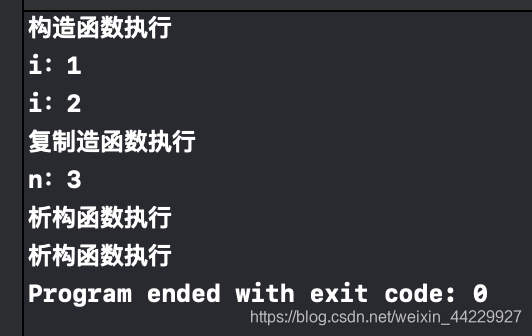参考
- 范磊C++(第11课时)
- VS 2015
笔记
实现成员的自加
- 通过编写成员函数
#include "stdafx.h"
#include <stdlib.h>
#include <iostream>
using namespace std;
class num
{
public:
num() { n = 1; }
~num() {}
int get() const { return n; }
void set(int x) { n = x; }
void add() { ++n; }//对象的自加功能(实际上是成员变量)
private:
int n;
};
int main(int argc, const char * argv[]) {
num i;
cout << "i:"<<i.get()<<endl;
i.add();
cout << "i:" << i.get() << endl;//通过调用add函数实现了自加,但是由于还要在类中定义函数比较麻烦。
system("pause");
return 0;
}
- 重载运算符
#include "stdafx.h"
#include <stdlib.h>
#include <iostream>
using namespace std;
class num
{
public:
num() { n = 1; }
~num() {}
int get() const { return n; }
void set(int x) { n = x; }
void add() { ++n; }
void operator ++() { ++n; }//相当于重载函数,函数体中是实现部分。
private:
int n;
};
int main(int argc, const char * argv[]) {
num i;
cout << "i:"<<i.get()<<endl;
i.add();
cout << "i:" << i.get() << endl;//通过调用add函数实现了自加,但是由于还要定义函数比较麻烦。
++i;
cout << "i:" << i.get() << endl;//重载运算符。
system("pause");
return 0;
}
后置自加 :链接: csdn.
- 创建临时对象
将自加后的对象传递给另一个对象。
#include "stdafx.h"
#include <stdlib.h>
#include <iostream>
using namespace std;
class num
{
public:
num() { n = 1; }
~num() {}
int get() const { return n; }
void set(int x) { n = x; }
void add() { ++n; }
num operator ++() //返回一个对象
{
++n;
num t;//临时对象
t.set(n);
return t;
}
private:
int n;
};
int main(int argc, const char * argv[]) {
num i;
cout << "i:"<<i.get()<<endl;
i.add();
cout << "i:" << i.get() << endl;//通过调用add函数实现了自加,但是由于还要定义函数比较麻烦。
++i;
cout << "i:" << i.get() << endl;//重载运算符。
num n = ++i;//传递给一个对象 //返回num类的临时对象,然后初始化给n
cout << "n:" << n.get() << endl;
system("pause");
return 0;
}
- 创建无名临时对象【有缺陷】
不用创建临时对象,用带参数的构造函数。
#include <iostream>
using namespace std;
class num
{
public:
num() { n = 1;cout<<"构造函数执行"<<endl; }
num(int i){n=i;cout<<"带参数的构造函数执行"<<endl;}
~num() {cout<<"析构函数执行"<<endl;}
int get() const { return n; }
void set(int x) { n = x; }
void add() { ++n; }
num operator ++() //返回一个对象
{
++n;
return num(n);//调用并且返回带参数的构造函数创建的临时对象,并且踏实没有名字的。//这种方法仍然不可取,因为对象的创建和析构都会浪费时间
}
private:
int n;
};
int main(int argc, const char * argv[]) {
num i;
cout << "i:"<<i.get()<<endl;
i.add();
cout << "i:" << i.get() << endl;//通过调用add函数实现了自加,但是由于还要定义函数比较麻烦。
++i;
cout << "i:" << i.get() << endl;//重载运算符。
num n = ++i;//传递给一个对象 //返回num类的临时对象,然后初始化给n
cout << "n:" << n.get() << endl;
return 0;
}
输出结果:

- 取消创建临时对象
创建一个对象需要牺牲一定的速度和一定的内存空间,但是我们只是要实现成员变量的自加。
#include <iostream>
using namespace std;
class num
{
public:
num() { n = 1;cout<<"构造函数执行"<<endl; }
num(int i){n=i;cout<<"带参数的构造函数执行"<<endl;}
num(const num&s){this->n=s.n;cout<<"复制造函数执行"<<endl;}
~num() {cout<<"析构函数执行"<<endl;}
int get() const { return n; }
void set(int x) { n = x; }
void add() { ++n; }
num operator ++() //返回一个对象
{
++n;
return *this;//用this来替换创造临时对象
//返回的是原始对象而不是临时对象,不用调用带参数的构造函数
//把返回的原始对象返回给新建的对象
//i->相当于复制了
}
private:
int n;
};
int main(int argc, const char * argv[]) {
num i;
cout << "i:"<<i.get()<<endl;
i.add();
cout << "i:" << i.get() << endl;//通过调用add函数实现了自加,但是由于还要定义函数比较麻烦。
// ++i;
//cout << "i:" << i.get() << endl;//重载运算符。
num n = ++i;//传递给一个对象 //返回num类的临时对象,然后初始化给n
cout << "n:" << n.get() << endl;
return 0;
}
输出对象:

重载运算符
- 加法运算符

#include <iostream>
using namespace std;
class num
{
public:
num() { n = 1;cout<<"构造函数执行"<<endl; }
num(int i){n=i;cout<<"带参数的构造函数执行"<<endl;}
num(const num&s){this->n=s.n;cout<<"复制造函数执行"<<endl;}
~num() {cout<<"析构函数执行"<<endl;}
int get() const { return n; }
void set(int x) { n = x; }
num add(const num&r) {
return num(n+r.get());
}
num operator ++() //返回一个对象
{
++n;
return *this;//用this来替换创造临时对象
//返回的是原始对象而不是临时对象,不用调用带参数的构造函数
//把返回的原始对象返回给新建的对象
//i->相当于复制了
}
private:
int n;
};
int main(int argc, const char * argv[]) {
num one(1), two(2), three;
three=one.add(two);
cout<<"one:"<<one.get()<<endl;
cout<<"two:"<<two.get()<<endl;
cout<<"three:"<<three.get()<<endl;
return 0;
}
输出结果:

这种加法不提倡使用
课件出现损坏无法观看
- 重载赋值运算符
课件损坏 - 转换类型运算符
#include <iostream>
using namespace std;
class A
{
public://构造函数只有一个参数,与下面的对应!
A(int x){i=x;cout<<"构造函数执行"<<i<<endl;}
~A(){cout<<"析构函数执行"<<i<<endl;}
void get(){cout<<i<<endl;}
private:
int i;
};
int main(int argc, const char * argv[]) {
A a(33);
a.get();
a=1000;//这时候就会创造临时对象(带参数的构造函数)
a.get();
a=A(2);//强制类型表达式//也是创造临时对象
a.get();
return 0;
}
输出结果:

此后三节课件均损坏
重载的限制: CSDN.